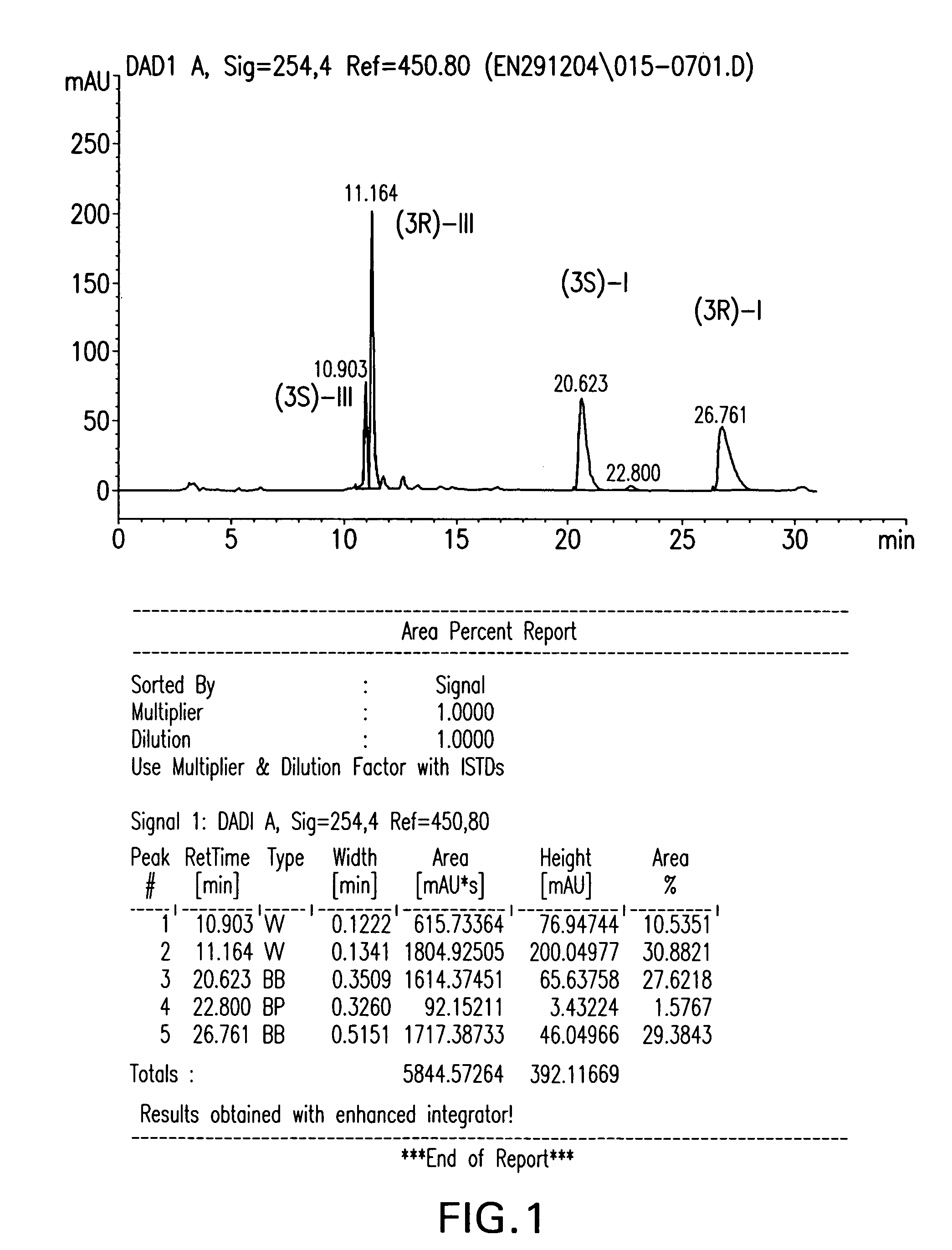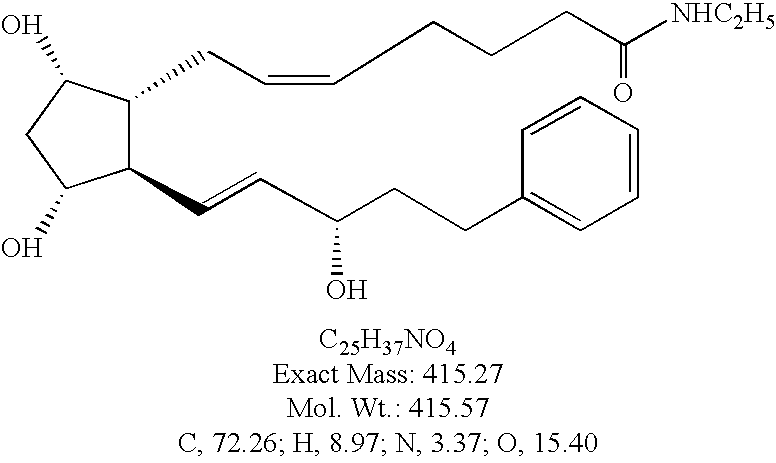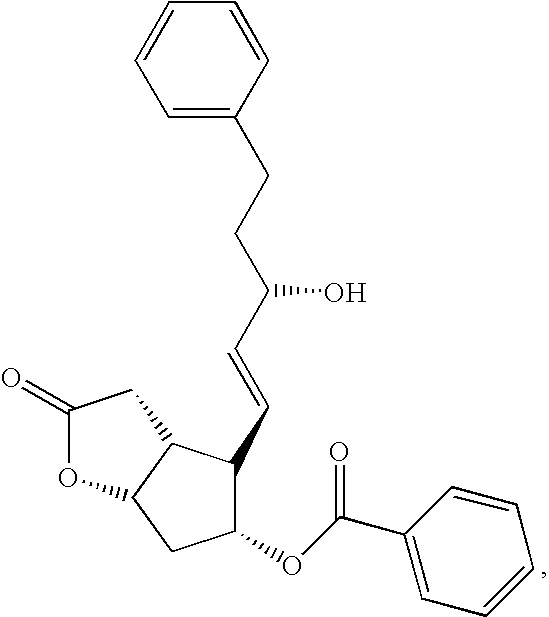Enzymatic transformation of a prostaglandin (bimatoprost) intermediate
a technology of prostaglandin and intermediate, applied in the field of prostaglandin bimatoprost, can solve the problems of unfavorable process for scale up, too close retention time to allow efficient separation in one chromatographic step, and still unfavorable process for stereoselective synthesis
- Summary
- Abstract
- Description
- Claims
- Application Information
AI Technical Summary
Benefits of technology
Problems solved by technology
Method used
Image
Examples
example 1
Selective Acetylation of (S)-I and (R)-I Epimers Using Pseudomonas stutzeri Lipase
[0054]The selective acetylation of the (S)-I and (R)-I epimers was carried out by introducing 10 mg (0.025 mmol) of a mixture, containing equimolar amounts of (S)-I and (R)-I, the C3 epimers of compound I, into a vial with 0.3 ml (3.2 mmol) of vinyl acetate, 6 ml of MTBE, and 100 mg of Pseudomonas stutzeri lipase (TL, Meito Sangyo, Japan). The resulting batch mixture was stirred at room temperature for 46 hours. Analysis of the stirred batch showed that, after reaction, the mixture contained 48 mole percent (R)-III, 2 mole percent unreacted (R)-I, and 50 mole percent unreacted (S)-I. Although the acetylation of the (R)-I epimer had proceeded with a yield of 96 percent, none of the (S)-I epimer in the original reaction mixture was acetylated under the reaction conditions, demonstrating the selectivity of the lipase enzyme. The acetylated product was separated from the unreacted alcohols by chromatograph...
example 2
Comparative Example by a Non-Selective Reaction
[0056]For comparison, a non-selective reaction was run with a different enzyme in an immobilized form by introducing 10 mg (0.025 mmol) of an enriched mixture of the compound I epimers, containing 35 mole percent (S)-I and 65 mole percent (R)-I, into a vial with 0.03 ml (0.32 mmol) of vinyl acetate, 3 ml of MTBE, and 4.6 mg of CLEC-PC (cross-linked lipase from Pseudomonas cepacia, Altus, USA). The resulting batch mixture was stirred at room temperature for 48 hours. An HPLC analysis of the mixture showed that, after reaction, the batch contained 8 mole percent (S)-III, 6 mole percent (R)-III, 59 mole percent (R)-I, and 27 mole percent (S)-I. Acetylation of the (S)-I epimer proceeded with a yield of about 23 percent, and the acetylation if the (R)-I epimer proceeded with a yield of about 9 percent.
example 3
Selective Acetylation of (S)-I and (R)-I Epimers Using Alcaligenes sp. Lipase
[0057]Selectivity was also found with an enzyme from Alcaligenes sp. lipase. The reaction was run by introducing 10 mg (0.025 mmol) of an enriched mixture of compound I epimers, containing 35 mole percent (S)-I and 65 mole percent (R)-I, with 0.03 ml (0.32 mmol) of vinyl acetate, 3 ml of MTBE, and 34 mg of lipase PL (Alcaligenes sp, Meito Sangyo, Japan). The resulting batch mixture was stirred at room temperature for 48 hours. After reaction, an HPLC analysis of the batch indicated the mixture contained 6 mole percent (R)-III, 59 mole percent (R)-I, and 35 mole percent non-reacted (S)-I. The acetylation of (R)-I proceeded with a yield of about 9 percent. However, as in example 1, none of the (S)-I reacted, demonstrating the selectivity of the enzyme.
PUM
| Property | Measurement | Unit |
|---|---|---|
| time | aaaaa | aaaaa |
| time | aaaaa | aaaaa |
| time | aaaaa | aaaaa |
Abstract
Description
Claims
Application Information
 Login to View More
Login to View More - R&D
- Intellectual Property
- Life Sciences
- Materials
- Tech Scout
- Unparalleled Data Quality
- Higher Quality Content
- 60% Fewer Hallucinations
Browse by: Latest US Patents, China's latest patents, Technical Efficacy Thesaurus, Application Domain, Technology Topic, Popular Technical Reports.
© 2025 PatSnap. All rights reserved.Legal|Privacy policy|Modern Slavery Act Transparency Statement|Sitemap|About US| Contact US: help@patsnap.com



